Key takeaways:
- Seasonal tasting events leverage fresh ingredients to evoke emotions and create memorable experiences for guests.
- Crafting a narrative around the menu helps enhance the dining experience, making food a medium of storytelling.
- Creating the right atmosphere, including decor and lighting, is essential to resonate with the seasonal theme and elevate the event.
- Engaging with guests and gathering feedback post-event is crucial for continuous improvement and tailoring future experiences.
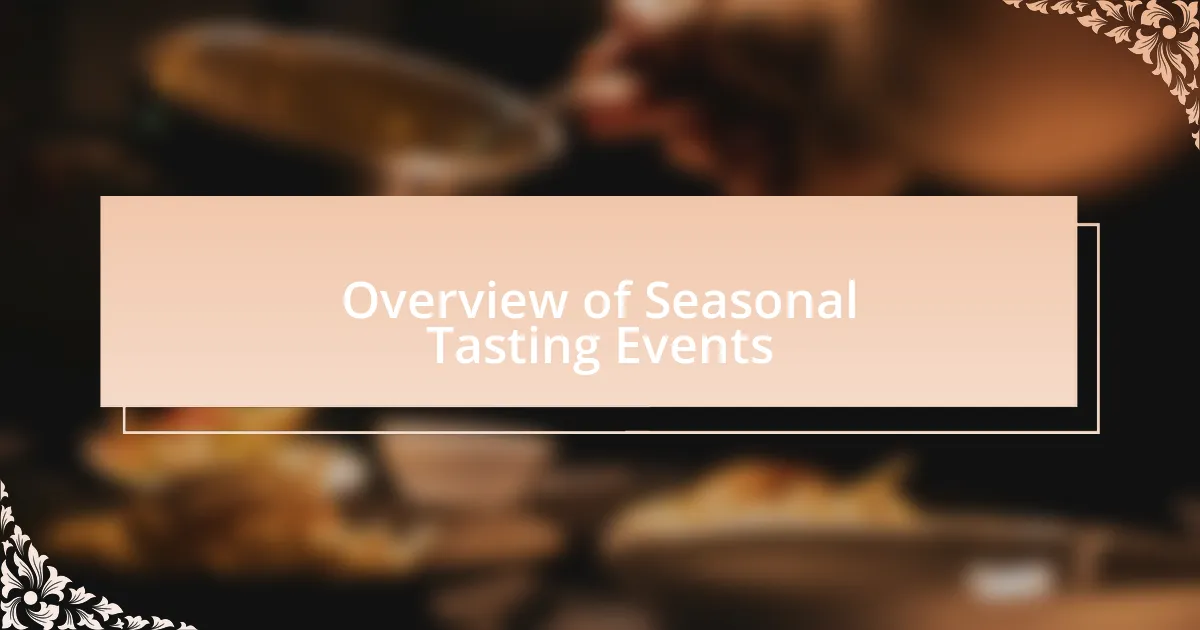
Overview of Seasonal Tasting Events
Seasonal tasting events are a delightful way to celebrate the bounty of each season, showcasing fresh ingredients and unique flavors. I remember hosting a fall tasting event where local pumpkins and spices took center stage, transforming simple dishes into comforting experiences. It’s incredible how the change of seasons can inspire creativity in the kitchen and create moments that resonate with guests.
What truly excites me about these events is the opportunity to create a narrative around the menu. For instance, I crafted a summer-themed tasting that featured dishes inspired by sun-ripened tomatoes and freshly picked herbs. As I watched guests savor each bite, their reactions reminded me just how powerful food can be in evoking memories and feelings. Doesn’t it feel special to share those seasonal vibes through a curated culinary experience?
Moreover, by tapping into seasonal themes, I believe we foster a deeper connection with our patrons. A winter tasting event focused on hearty flavors can unite friends and family for holiday gatherings, creating a warm atmosphere that lingers long after the last plate is cleared. Sharing these moments, coupled with thoughtful wine pairings, turns dining into an occasion that nourishes both body and soul.

Importance of Seasonal Ingredients
Using seasonal ingredients is essential for a multitude of reasons. First, there’s the undeniable freshness factor; when ingredients are in season, they’re not only at their peak flavor but also more nutritious. I often recall a summer brunch where I featured fresh berries and garden vegetables. The vibrant, ripe flavors transformed the dishes, leaving guests buzzing about the freshness long after they left the table.
Additionally, seasonal ingredients support local agriculture, which is a practice I wholeheartedly support. I make it a point to source produce from nearby farms, forging connections within the community. It feels incredible to know that by serving seasonal dishes, I’m contributing to the local economy and promoting sustainable eating practices. Have you ever taken a bite of something and felt an immediate sense of place? That’s the magic of eating with the seasons.
Lastly, there’s an emotional resonance with seasonal ingredients that I cherish deeply. Each season brings unique memories and feelings tied to specific foods, from cozy winter stews to sunny summer salads. Last autumn, I created a dish inspired by my grandmother’s harvest soup, and it transported me back to her kitchen, filled with laughter and warmth. Isn’t it incredible how food can evoke such powerful memories? That’s the beauty of harnessing seasonal ingredients—they tell stories and forge connections that transcend the plate.
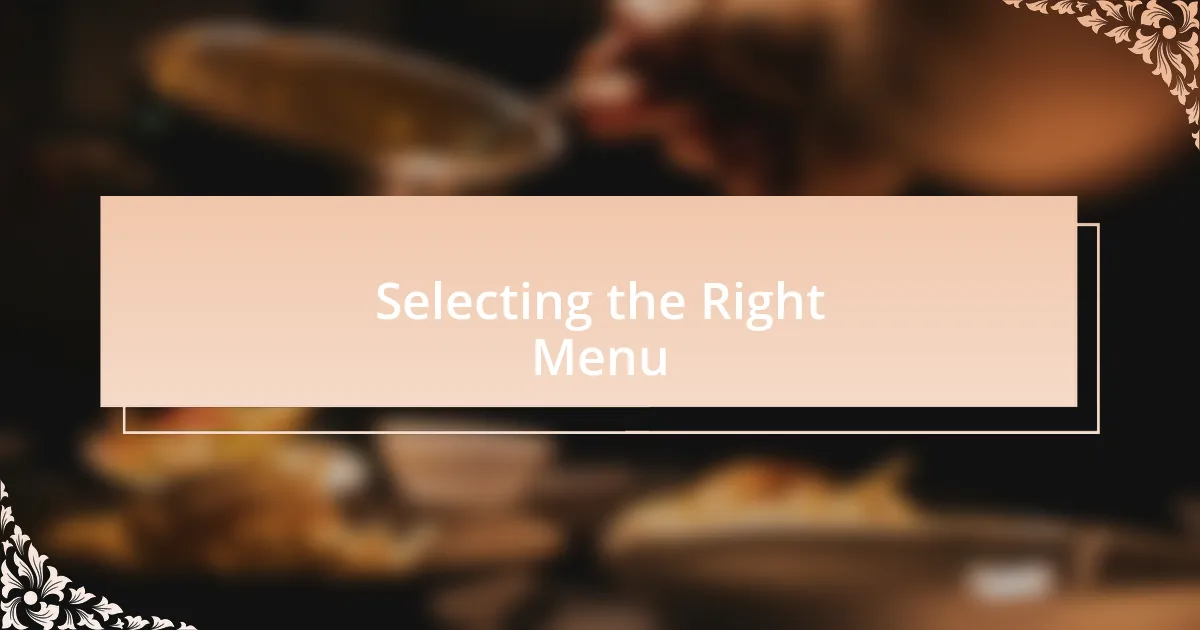
Selecting the Right Menu
Selecting the right menu for a seasonal tasting event hinges on blending creativity with what’s available. I often start by brainstorming dishes that highlight those fresh, local ingredients, considering how they can come together in a cohesive experience. For instance, during spring, I love crafting a light, refreshing menu that includes a vibrant asparagus tart paired with a zesty lemon vinaigrette—it really captures the essence of the season, don’t you think?
When I’m curating my menu, I also consider the overall theme of the event. I recall one year when I hosted a fall tasting event inspired by comforting childhood memories. I created a warm butternut squash risotto topped with crispy sage, and it struck a chord with guests who shared their own stories around autumn flavors. How often have you found that a dish can bring you back to a cherished moment in time?
Ultimately, it’s about the guests’ experience and how the menu reflects the season. I often find myself asking, “What stories do I want to tell through these dishes?” It’s crucial to make choices that invite guests to savor not just the food, but the emotions and memories tied to those seasonal ingredients. Crafting such a menu turns a meal into a narrative—a delightful journey through flavors and feelings.
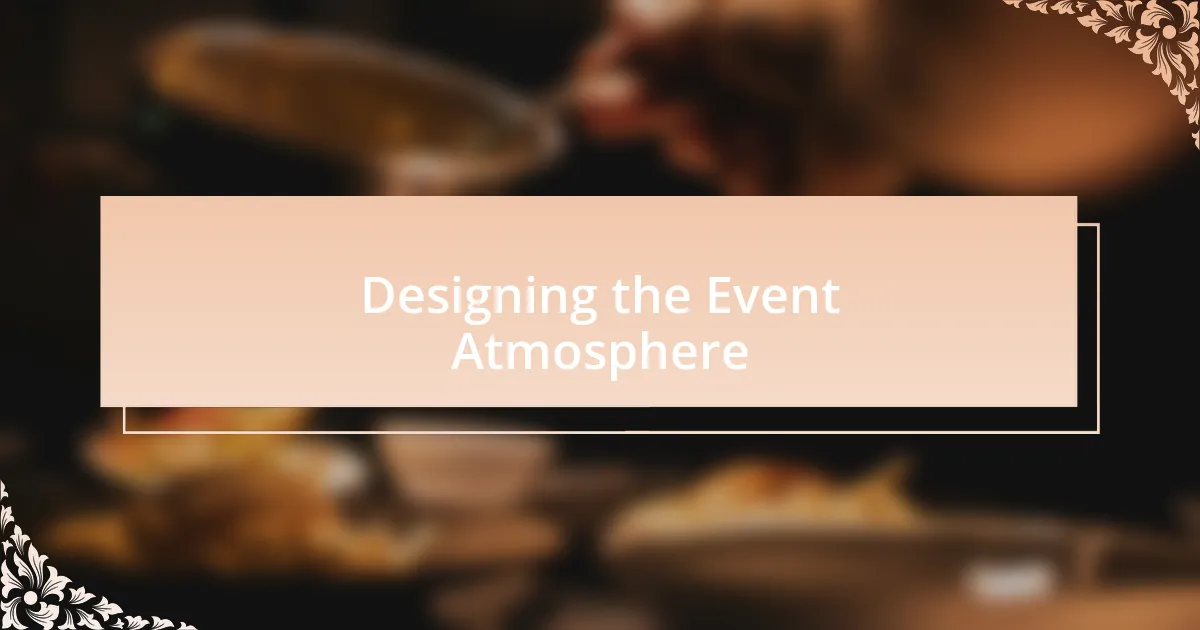
Designing the Event Atmosphere
Creating the right atmosphere for a seasonal tasting event is about immersing guests in the season’s spirit. I like to think of the ambiance as an extension of the menu—each element should resonate with the flavors being served. For one spring gathering, I opted for pastel table settings with eclectic flower arrangements, which instantly brightened the space and invited conversations about the blossoming season. How do you think a simple decor change can shift the energy of an event?
Lighting plays a crucial role, too. Soft, warm lights create a cozy vibe, setting the stage for a relaxed dining experience. At a recent winter tasting, I used string lights combined with candlelit tables, which evoked the feeling of gathering around a hearth on a chilly evening. Isn’t it fascinating how lighting can evoke a specific emotion, transforming even the simplest of dishes into something magical?
Additionally, I find that incorporating seasonal elements into the decor helps to enhance the experience. For a summer event, I once filled the space with rustic wooden accents and fresh herbs, creating not just a feast for the palate but for the senses as well. This little touch made guests feel as if they were dining al fresco in a sun-drenched garden. How often have you noticed details like these wrapping you in a moment that lingers long after the meal is over?
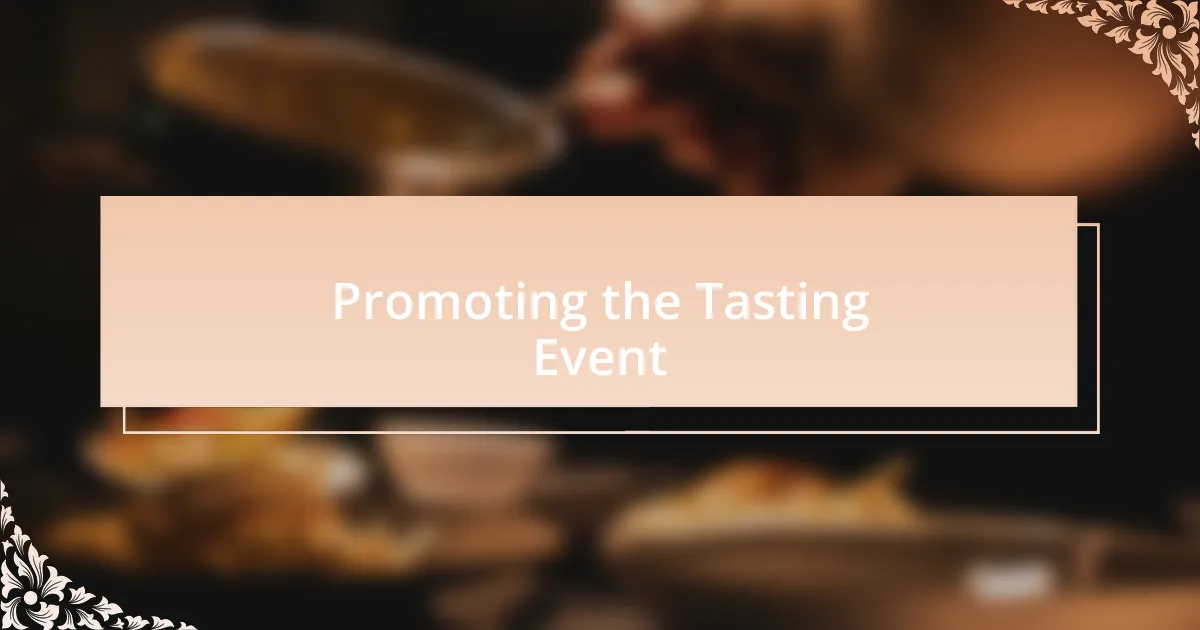
Promoting the Tasting Event
When it comes to promoting a seasonal tasting event, I’ve found that social media is a powerful ally. Last fall, I created a series of engaging posts showcasing sneak peeks of seasonal dishes, featuring vibrant images that captured the essence of autumn. Isn’t it amazing how a well-crafted photo can spark anticipation and bring guests closer to the event?
I also believe in the importance of leveraging relationships with local influencers and food bloggers. A few months ago, I invited a local food enthusiast to preview my spring menu, and their positive review drove a huge turnout. It’s interesting how a fresh perspective can amplify your reach; have you considered how much influence a single voice can have in your community?
Finally, I can’t stress enough the benefit of personalized invitations. I recently sent handwritten invites to loyal customers for a special tasting. This small touch made them feel valued and excited to join. Isn’t it true that creating a sense of exclusivity can turn an ordinary event into something memorable for guests?
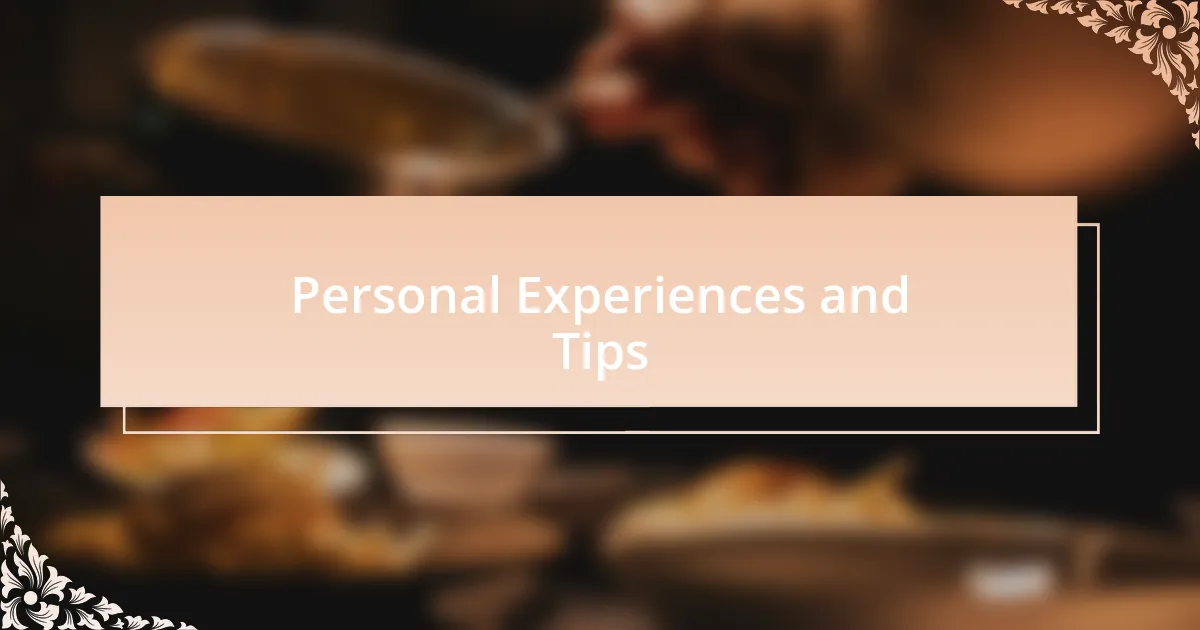
Personal Experiences and Tips
Hosting seasonal tasting events has given me a treasure trove of insights, especially in how to create a warm and inviting atmosphere. I remember one particular event where I transformed the dining space with seasonal decorations—think rustic fall leaves and soft, ambient lighting. It felt cozy and welcoming, and guests commented on how it made them feel right at home. Have you ever noticed how the setting can drastically change the mood of an event?
One strategy I swear by is involving my staff in the planning process. During the last winter tasting, I asked my team for their input on the menu. This not only sparked their creativity but also made them feel invested in the event’s success. I was truly amazed by the passion they brought to the table—literally. Isn’t it fascinating how collaboration can elevate an experience?
Lastly, I encourage you to capture the moments during your event. I took candid photos of guests enjoying the food and sharing laughs at the last tasting. These moments became cherished memories and created engagement for future promotions. Have you thought about how these snapshots could tell your restaurant’s story long after the event is over?
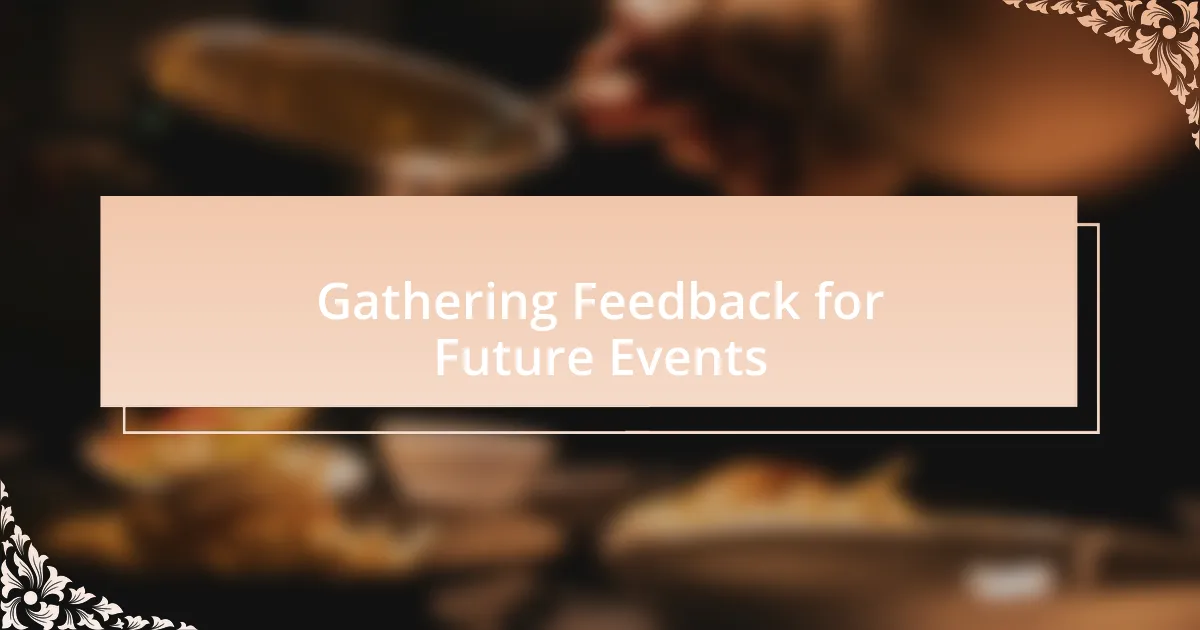
Gathering Feedback for Future Events
Gathering feedback after your tasting events is crucial for enhancing future experiences. After each event, I make it a point to send out a simple survey to attendees, asking for their thoughts on everything from the menu to the ambiance. The responses can be eye-opening. For instance, I once received feedback that a highlighted dish, which I thought was a crowd-pleaser, didn’t resonate as well as anticipated. Doesn’t it make you reconsider what you believe versus what your guests feel?
I’ve also found that informal discussions with guests while they are savoring their meals yield rich insights. One time, while mingling at a summer tasting, I struck up a conversation with a couple who loved the cocktail pairing but found the dessert too sweet for their taste. Their honest feedback sparked an idea for a more balanced dessert option in the next event. Have you ever had a conversation that inspired a major change in your approach?
Lastly, I always remind my staff to share their perspectives, as they play a vital role in guests’ experiences. During the last event, one of my servers mentioned that guests frequently asked about the wine pairing suggestions. This prompted me to create a dedicated menu item for future tastings that includes personalized drink pairings. It’s amazing how different viewpoints can lead to memorable enhancements, right?